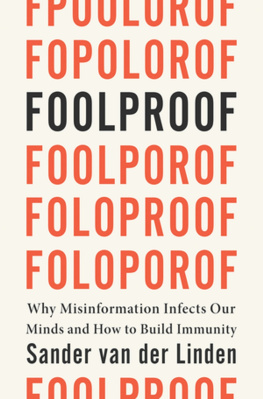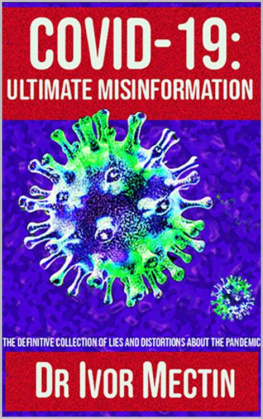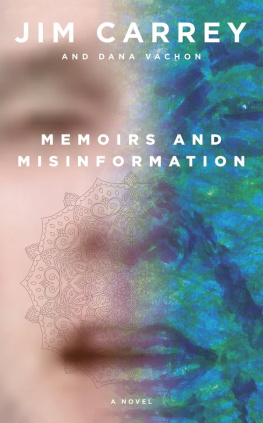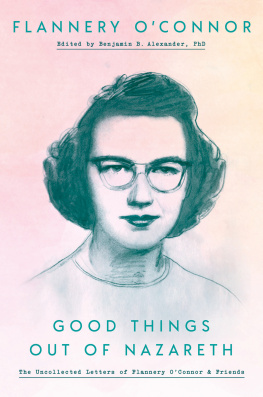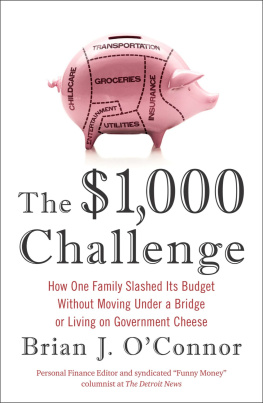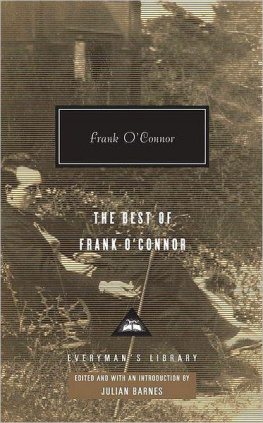Cailin OConnor - The Misinformation Age
Here you can read online Cailin OConnor - The Misinformation Age full text of the book (entire story) in english for free. Download pdf and epub, get meaning, cover and reviews about this ebook. year: 2019, publisher: Yale University Press, genre: Romance novel. Description of the work, (preface) as well as reviews are available. Best literature library LitArk.com created for fans of good reading and offers a wide selection of genres:
Romance novel
Science fiction
Adventure
Detective
Science
History
Home and family
Prose
Art
Politics
Computer
Non-fiction
Religion
Business
Children
Humor
Choose a favorite category and find really read worthwhile books. Enjoy immersion in the world of imagination, feel the emotions of the characters or learn something new for yourself, make an fascinating discovery.

- Book:The Misinformation Age
- Author:
- Publisher:Yale University Press
- Genre:
- Year:2019
- Rating:5 / 5
- Favourites:Add to favourites
- Your mark:
- 100
- 1
- 2
- 3
- 4
- 5
The Misinformation Age: summary, description and annotation
We offer to read an annotation, description, summary or preface (depends on what the author of the book "The Misinformation Age" wrote himself). If you haven't found the necessary information about the book — write in the comments, we will try to find it.
The Misinformation Age — read online for free the complete book (whole text) full work
Below is the text of the book, divided by pages. System saving the place of the last page read, allows you to conveniently read the book "The Misinformation Age" online for free, without having to search again every time where you left off. Put a bookmark, and you can go to the page where you finished reading at any time.
Font size:
Interval:
Bookmark:
The Misinformation Age
Misinformation
Age
How False Beliefs Spread
Cailin OConnor
James Owen Weatherall

Published with assistance from the foundation established in memory of Calvin Chapin of the Class of 1788, Yale College.
Copyright 2019 by Cailin OConnor and James Owen Weatherall.
All rights reserved.
This book may not be reproduced, in whole or in part, including illustrations, in any form (beyond that copying permitted by Sections 107 and 108 of the U.S. Copyright Law and except by reviewers for the public press), without written permission from the publishers.
Yale University Press books may be purchased in quantity for educational, business, or promotional use. For information, please e-mail (U.K. office).
Set in Janson Roman type by Integrated Publishing Solutions.
Printed in the United States of America.
Library of Congress Control Number: 2018940288
ISBN 978-0-300-23401-5 (hardcover : alk. paper)
A catalogue record for this book is available from the British Library.
This paper meets the requirements of ANSI/NISO Z39.48-1992 (Permanence of Paper).
10 9 8 7 6 5 4 3 2 1
To Eve and Vera
INTRODUCTION
The Vegetable Lamb of Tartary
ONE
What Is Truth?
TWO
Polarization and Conformity
THREE
The Evangelization of Peoples
FOUR
The Social Network
Throughout the text, we use the plural pronouns they and them to refer to individual (i.e., singular) agents in mathematical and computational models of social learning. This usage follows the practice in the relevant academic literature. Although it may seem strange to some readers, the idea is to both (1) avoid assigning a gender to an abstract entity and (2) preserve the sense of agency of those entities, which would be lost if one were to use the singular it.
The Misinformation Age
The Vegetable Lamb of Tartary
In the middle part of the fourteenth century, a text purporting to be the travel memoirs of an English knight named Sir John Mandeville began to circulate among the learned of Europe. Mandeville, the text claimed, had traveled through Asia Minor, northern Africa, and into India and had experienced many things unknown in Western Europe. Among these wonders was an Indian tree bearing gourdlike fruit, within which could be found tiny lambs, complete with flesh and blood. Mandeville claimed to have eaten this fruit and to have found it wondirfulle.
He was not the only writer of the period to comment on these strange plants. An Italian friar named Odoric, who had also traveled through the East, wrote of a similar experience about thirty years before Mandeville.
These reports of lamb-plants, which came to be known as the Vegetable Lamb of Tartary, captured the medieval imagination. The Vegetable Lamb was reported as fact by leading naturalists and
Even during its heyday, the Vegetable Lamb had its skeptics. Baron von Herberstein, a sixteenth-century ambassador to Russia from the Holy Roman Empire, reported that the Vegetable Lamb initially struck him as fabulous. But as he looked into the matter, he gradually became a believer, particularly after so many people of credence described their direct experiences with the delicious flesh and downy snow-white wool of these lamb-pods. The various stories he heard differed so little that he came to believe that there was more truthfulness in this matter than he had supposed.
Of course, there is no such plant and never was. Nor are there other such hybrids. But it took nearly four centuries after Mandevilles writings appeared for European botanists and biologists to recognize the Vegetable Lamb for a myth. In 1683, a Swedish naturalist named Engelbert Kaempfer, on direct order from King Charles XI, undertook a systematic search in Asia Minor and established conclusively that there simply are no Vegetable Lambs in the world.
How could it happen that, for centuries, European scholars could assertwith apparent certainty and seriousnessthat lambs grew on trees? How could a belief with no supporting evidence, a belief that should have appearedgiven all available experience concerning both plants and animals, and, indeed, regular exposure to lambssimply absurd, nonetheless persist for centuries?
More important, are the mechanisms by which such beliefs were formed and spread, even among so-called experts, still present? What are todays Vegetable Lambs, and how many of us believe in them?
On September 26, 2016, about six weeks before Donald Trump was elected president of the United States, a website calling itself ETF News (
The FBI... has exposed itself as corrupted by political forces that have become far too powerful, said the Pope, according to ETF News. Though I dont agree with Mr. Trump on some issues, I feel that voting against the powerful political forces that have corrupted the entire American federal government is the only option for a nation that desires a government that is truly for the people and by the people. The article was shared or liked on Facebook 960,000 times between when it was posted and the election. (The total number of users who saw the article, and even clicked on it, is perhaps ten times higher.)
Had the Pope endorsed Trump, it would have been major news, covered widely by many news organizations and surely deserving of attention. But it never happened. The entire story was fabricated.
The papal endorsement was the biggest fake news story of the election cycle, but it was hardly an outlier. An analysis by Craig Silverman at BuzzFeed News found that the top twenty fake news stories in the three months before the election were shared or liked a total of 8.7 million times on Facebook. Over the same period, the top twenty news stories from reputable sources got only 7.3 million Facebook shares or likes. In another study, economists Hunt Allcott at New York University and Matthew Gentzkow at Stanford compiled a database of 115 pro-Trump and 41 pro-Clinton fake news stories that, together, were shared 38 million times in the weeks before the election. These shares, they estimated, led to hundreds of millions of click-throughs. They also produced a list of fake news sites that, together, had 159 million visits between October 8 and November 8.
ETF News was particularly successful: five of its stories made the top twenty list, and together those stories were responsible for 3.5 million shares or likes during this period. tion, and that President Barack Obama had cut the pay of US military personnel.
In one noteworthy case, an ETF News story about the television host Megyn Kelly became a trending topic on Facebook and was actively promoted by the site. The article claimed that Kelly had been exposed as a traitor and fired from Fox News for supporting Hillary Clinton. (A feud between Trump and Kelly had begun at a Republican primary debate on August 6, 2015, when Kelly asked Trump a pointed question about his past derogatory statements about women. Trump later made remarks that were widely interpreted as suggesting that Kellys criticisms were due to her menstrual cycle.)
None of these stories was true. Many were not even original but were lifted directly from other fake news websites. The papal endorsement story, for instance, was originally posted on a site called WTOE 5 News, part of a network of fake news sites that drove traffic by claiming that celebrities were planning to move to various small towns in the United States.. Somehow, though, the versions posted on ETF News were shared far more on social media than the originals.
Next pageFont size:
Interval:
Bookmark:
Similar books «The Misinformation Age»
Look at similar books to The Misinformation Age. We have selected literature similar in name and meaning in the hope of providing readers with more options to find new, interesting, not yet read works.
Discussion, reviews of the book The Misinformation Age and just readers' own opinions. Leave your comments, write what you think about the work, its meaning or the main characters. Specify what exactly you liked and what you didn't like, and why you think so.

